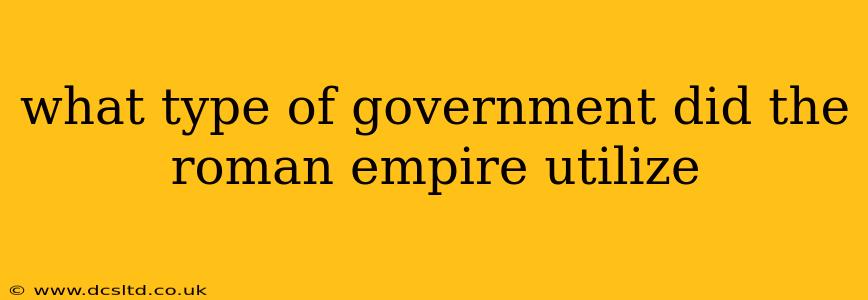The Roman Empire's government was a complex and evolving system, not easily categorized into a single type. Over its centuries-long existence, it transitioned through several forms, most notably from a Republic to an Empire. Understanding the Roman government requires examining its key phases and characteristics.
From Republic to Empire: A Shifting Power Structure
Initially, Rome operated as a republic, a system characterized by elected officials and representative bodies. However, this wasn't a pure democracy. Power was distributed among various institutions:
- The Senate: A powerful body of aristocratic members, advising on policy and managing finances. Its influence waxed and waned throughout the Republic's history.
- The Assemblies: Various assemblies represented different segments of Roman society (patricians, plebeians, etc.), voting on laws and electing officials. Their power also fluctuated over time, often overshadowed by the Senate or powerful individuals.
- The Consuls: Two annually elected chief executives with significant power, commanding the army and presiding over the Senate.
- Other Magistrates: Various officials with specific responsibilities, like praetors (judges) and censors (population registrars), held significant power within their domains.
This republican system, however, ultimately gave way to imperial rule. The transition wasn't abrupt; it was a gradual process marked by increasing concentration of power in the hands of individuals. The late Republic saw a period of civil wars and political instability, culminating in the rise of Augustus, the first Roman emperor.
The Principate: A Clever Disguise of Autocracy
Augustus cleverly avoided openly declaring himself a king or dictator, instead establishing a system known as the Principate. He maintained many republican institutions, but effectively controlled them. The emperor held significant power, including:
- Imperium: Supreme military command.
- Tribune Power: The right to propose legislation and veto others.
- Proconsular Power: Control over provinces.
This system preserved the façade of the Republic while consolidating power in the emperor's hands. This delicate balance was maintained for several centuries, albeit with varying degrees of success. Later emperors often wielded greater power, and republican institutions became increasingly ceremonial.
The Dominate: Absolute Imperial Authority
The late Roman Empire saw the shift to the Dominate, a period of more overt autocracy. This began with Diocletian, who introduced significant reforms, including:
- Tetrarchy: Division of the empire into four administrative regions ruled by two senior Augusti and two junior Caesars. This aimed to improve administration and stability.
- Increased Centralization: More centralized control over the provinces and the military.
- Emphasis on Imperial Authority: The emperor's authority was made far more absolute and less subject to traditional republican restraints.
This system continued under Constantine and his successors, solidifying the emperor's role as an absolute ruler, though the administrative apparatus remained complex. The Senate continued to exist, but its power was largely symbolic.
Was it a Monarchy? A Dictatorship?
While the Roman Empire ultimately became autocratic, it wasn't simply a monarchy in the traditional sense. The emperors weren't hereditary rulers in the early stages. Succession was often determined by political maneuvering, military support, or adoption. Likewise, calling it a dictatorship isn't entirely accurate, as the system was far more complex and institutionalized than a simple dictatorship. The Roman Empire's government was a unique blend of elements—a hybrid system evolving over centuries, characterized by shifting balances of power among various institutions and individuals.
What were the main challenges faced by the Roman government?
The Roman government faced many challenges throughout its history. These included maintaining stability amidst internal power struggles (civil wars), managing vast territories and diverse populations, dealing with economic issues like inflation and corruption, and defending against external threats.
How did the Roman government affect the lives of ordinary citizens?
The Roman government's impact on ordinary citizens varied greatly depending on the period and their social class. It provided infrastructure (roads, aqueducts), laws, and public order, but also taxation, conscription, and sometimes oppression.
What were the major differences between the Roman Republic and the Roman Empire?
The major difference lies in the distribution of power. The Republic featured a more complex system of checks and balances among various institutions, while the Empire concentrated power in the hands of the emperor. The Republic was theoretically representative, while the Empire was autocratic.
How did the Roman government evolve over time?
The Roman government went from a republic with competing power structures to a centralized empire with absolute imperial power, a gradual transition marked by periods of instability and crucial reforms. This evolution was driven by internal political struggles, external pressures, and the need for efficient administration of a vast and diverse territory.
